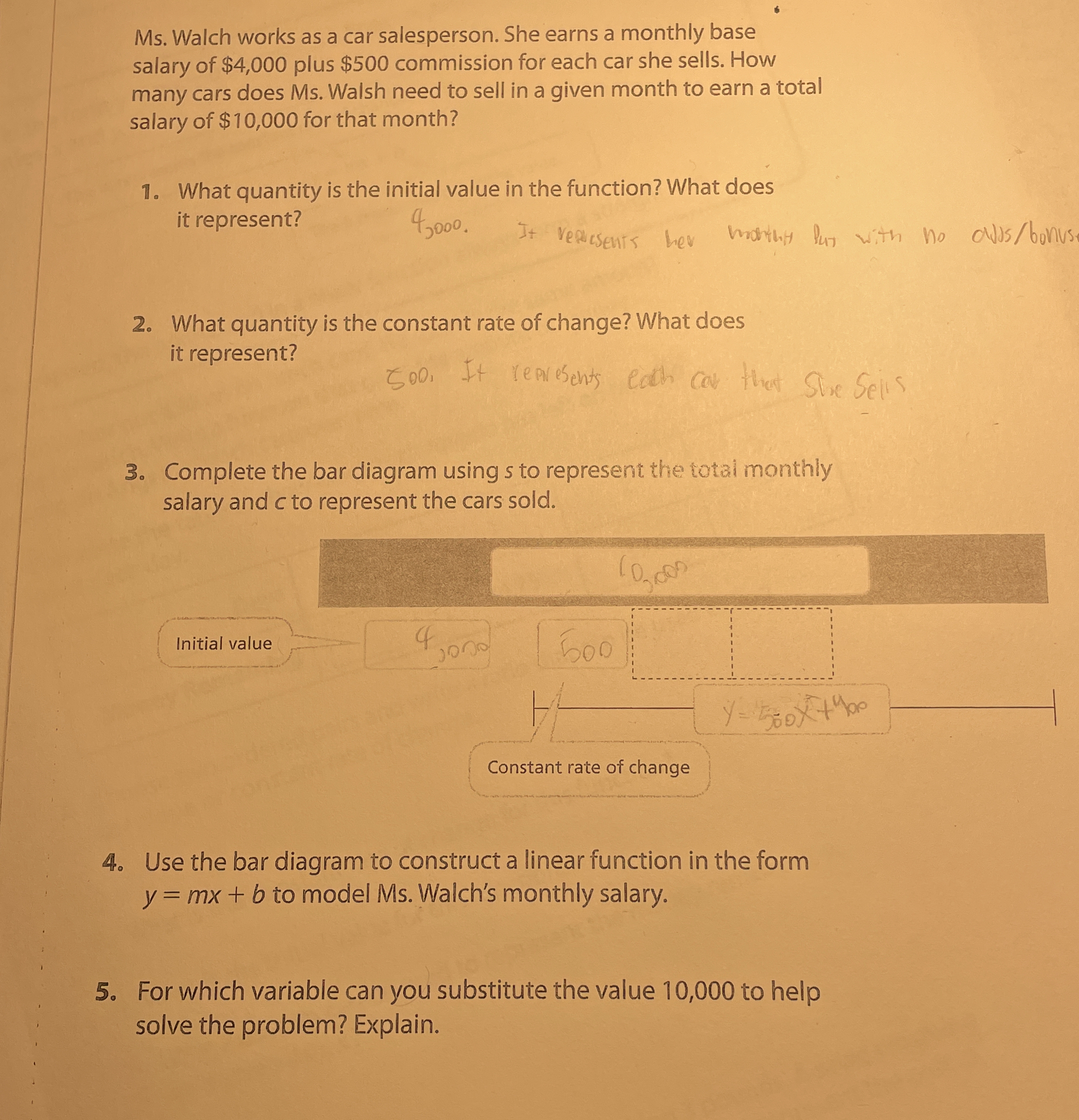Ms. Walch works as a car salesperson. She earns a monthly base salary of $4,000 plus $500 commission for each car she sells. How many cars does Ms. Walsh need to sell in a given mo... Ms. Walch works as a car salesperson. She earns a monthly base salary of $4,000 plus $500 commission for each car she sells. How many cars does Ms. Walsh need to sell in a given month to earn a total salary of $10,000 for that month? 1. What quantity is the initial value in the function? What does it represent? 2. What quantity is the constant rate of change? What does it represent? 3. Complete the bar diagram using s to represent the total monthly salary and c to represent the cars sold. 4. Use the bar diagram to construct a linear function in the form y = mx + b to model Ms. Walch's monthly salary. 5. For which variable can you substitute the value 10,000 to help solve the problem? Explain.

Understand the Problem
The image contains a word problem related to a car salesperson's salary, which includes a base salary and commission per car sold. The problem asks to determine how many cars the salesperson needs to sell to reach a target total salary. It also involves identifying the initial value and rate of change in the context of the problem, completing a bar diagram, constructing a linear function, and determining where to substitute a given value.
Answer
Ms. Walch needs to sell 12 cars. 1. Initial value: $4000 2. Rate of change: $500 3. Bar diagram description in "answer" section 4. $y = 500x + 4000$ 5. Substitute 10,000 for $y$.
Answer for screen readers
Ms. Walch needs to sell 12 cars to earn a total salary of $10,000.
-
The initial value is $4,000. It represents her monthly base salary.
-
The constant rate of change is $500. It represents the commission she earns for each car she sells.
-
The bar diagram should show the total salary ($10,000) divided into two parts: the base salary ($4,000) and the commission from selling cars ($6,000). The commission part should be further divided into 12 equal parts, each representing $500 commission from one car.
-
The linear function is $y = 500x + 4000$.
-
You can substitute the value 10,000 for $y$. It represents the total salary, and substituting it into the equation allows us to solve for $x$, the number of cars needed to be sold to reach that salary.
Steps to Solve
- Identify the initial value
The initial value is the base salary Ms. Walch earns regardless of how many cars she sells. This is given as $4,000.
- Identify the constant rate of change
The constant rate of change is the commission she earns for each car she sells, which is $500 per car.
- Complete the bar diagram
The bar diagram should represent the total salary $s$ as the sum of the initial value ($4,000) and the commission from selling cars ($500c$). Since we want to find the number of cars to sell to reach $10,000, the diagram should show $10,000 at the top, $4,000 as the initial value, and the remaining portion representing the commission earned from selling cars. This remaining portion would be $10,000 - $4,000 = $6,000. This $6,000 is made up of $c$ number of $500 commissions, so we can divide the $6,000 into $c$ boxes representing the commission from each car. Since the original answer shows only one box with $500, it is incomplete.
- Construct a linear function
Using the form $y = mx + b$, we can model Ms. Walch's salary. Here, $y$ represents the total salary, $m$ is the commission per car, $x$ is the number of cars sold, and $b$ is the base salary. So the function becomes $y = 500x + 4000$.
- Determine where to substitute the value
To find out how many cars Ms. Walch needs to sell to reach a total salary of $10,000, we need to substitute the total salary ($10,000) for $y$ in the equation $y = 500x + 4000$. This allows us to solve for $x$, the number of cars sold.
- Solve for the number of cars
Substitute $y = 10000$ into the equation $y = 500x + 4000$: $10000 = 500x + 4000$
Subtract 4000 from both sides: $10000 - 4000 = 500x$ $6000 = 500x$
Divide both sides by 500: $x = \frac{6000}{500}$ $x = 12$
Ms. Walch needs to sell 12 cars to earn a total salary of $10,000.
-
The initial value is $4,000. It represents her monthly base salary.
-
The constant rate of change is $500. It represents the commission she earns for each car she sells.
-
The bar diagram should show the total salary ($10,000) divided into two parts: the base salary ($4,000) and the commission from selling cars ($6,000). The commission part should be further divided into 12 equal parts, each representing $500 commission from one car.
-
The linear function is $y = 500x + 4000$.
-
You can substitute the value 10,000 for $y$. It represents the total salary, and substituting it into the equation allows us to solve for $x$, the number of cars needed to be sold to reach that salary.
More Information
This problem is a classic example of a linear equation application in real-world scenarios. Understanding base salaries and commissions is important when analyzing income.
Tips
A common mistake is confusing the initial value and the rate of change. The initial value is the starting point (base salary), and the rate of change is how much the salary increases per car sold (commission). Another mistake is substituting the target salary for the wrong variable in the linear equation. Make sure to substitute it for $y$, the total salary, not $x$, the number of cars sold.
AI-generated content may contain errors. Please verify critical information